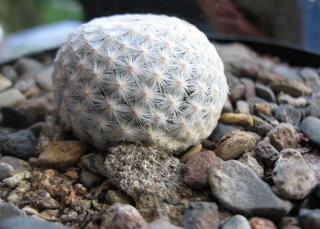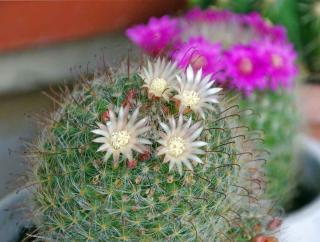

Key Mammillaria facts:
Botanical name – Mammillaria spp.
Common name – Mammillaria, pillow cactus, cushion cactus, and more depending on the species
Family – Cactaceae
Type – Cactus
Height – 16 inches (40 cm)
Use – pot
Exposure – light, but without direct light
Soil – sandy, gravely, well-drained, dry
Planting – spring
Flowering – May to June
Native to Latin America and to the Southern United States, the Mammillaria genus includes 180 different species, among which you’ll find: M. candida, M. longiflora, and also M. plumosa… However, those species most commonly found in garden stores are without a doubt Mammillaria elongata and Mammillaria matudae.
These small cylindrical or spherical cacti never grow any larger than 8 inches across for 16 inches in height (20 cm wide and 40 cm tall). Their areoles are equipped with spikes which, depending on the species, are sometimes covered with woolly, silky strands. These cacti often start off as solitary growers, then bunch out as many spontaneous side shoots appear.
They flower during the day with funnel-shaped blooms set all around the top crown. Each flower ranges from 1/4th in to nearly 2 inches (7 to 40 mm), and colors range from white, yellow orange to pink and red, depending on the species. Blooming generally occurs in spring, and each flower is followed by small oval fruits that are green or red.
Mammillaria are frost-vulnerable cactus, so they cannot be planted outdoors unless your climate has very mild winter temperatures. The lowest they can take is 40°F (5°C). Generally, in temperate climates, it’s grown in pots, except for the following few species: M. polythele forma nuda, M. backebergiana, M. elongata, M. karwinskiana ssp. nejapensis, M. obconella, M. petterssonii and M. rhodantha, since each of these can take cold waves when they don’t last too long.
 Fill a pot with loose, airy and extremely well-draining substrate, the “3 thirds” type (1/3rd sand, 1/3 soil mix, 1/3 garden soil).
Fill a pot with loose, airy and extremely well-draining substrate, the “3 thirds” type (1/3rd sand, 1/3 soil mix, 1/3 garden soil).You can propagate your Mammillaria by separating offshoots from the mother plant. It’s an operation that is more or less delicate depending on the species, since this influences how many offshoots appear, how often they do so, and whether they’re easy to reach or not.
In general, Mammillarias are easy indoor plants to grow because they don’t require much care. Only water your mammillaria during the summer, once every 10 days at most, and make sure the bottom of the pot never wallows in water. In fall, water even less, and stop watering entirely during the whole winter season: this is the normal dormant season for this little cactus. Watering can resume incrementally in the following spring.

In general, Mammillaria call for repotting in spring every 3 years. Simply follow the same planting steps as above.
Mammillaria cacti are resistant to most diseases, except for rot in case of too much water or moisture. On rare occasions, you might find that they’re under attack by scale insects, red spider mites or nematodes.
To learn more, read: